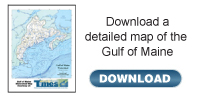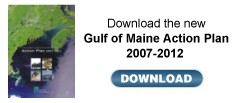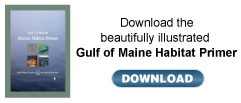Herring: A small fish that is a big deal
By Kirsten Weir
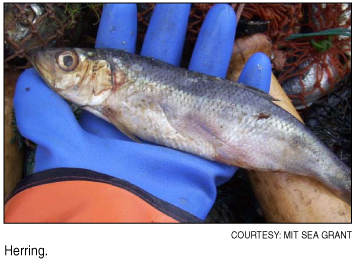 “The bean of coffee, the leaves of tea, the spices
of the tropics, the worms that make silk, are of smaller influence
on the nations (sic) richness than the herring of the Atlantic
Ocean.” “The bean of coffee, the leaves of tea, the spices
of the tropics, the worms that make silk, are of smaller influence
on the nations (sic) richness than the herring of the Atlantic
Ocean.”
So wrote the French naturalist Bernard Germain de Lacépède
more than two centuries ago. Times have changed since early American
settlers first plucked the small silver fish from the waters of
the Gulf of Maine. The herring’s importance, however, hasn’t
diminished. “For a small fish,” noted Peter Baker, project
manager of the Pew Environment Group’s Herring Alliance,
“herring are a really big deal.”
The Gulf of Maine herring fishery is coming under scrutiny
this year. Last fall, the Herring Alliance—a coalition of
environmental groups and some fishermen—ran a campaign urging
New England residents to voice their concerns about the fishery,
such as fishing practices, to bolster support for making it a
priority fish to protect. As a result, the New England Fisheries
Management Council (NEFMC) received some 8,000 public comments
by email. In November 2007, the NEFMC voted to reexamine herring
regulation, adding the species to its 2008 management priority
list. “The council made an important decision today to fix
the Atlantic herring fishery,” Baker said in a statement
issued immediately after the NEFMC vote. Yet not everyone agrees
the fishery is broken.
Atlantic herring are small, streamlined fish reaching up to
10-14 inches (25-35 centimeters) in length that form enormous
schools in the open waters and offshore banks of the Gulf of Maine.
Herring hold a key spot in the middle of the food chain. They
filter plankton from the water and are an important food source
for large predators such as tuna, whales and sharks. “They
eat really small things and are eaten by really big things,”
Baker said. “They are some of the most nutritious foods available
for the animals that feed on them.”
Herring have long been important for humans as well. Traditionally,
they were harvested from fixed-gear traps called weirs, or caught
in purse-seine nets drawn around their schools as they surfaced
at night to feed on plankton. In parts of Canada, such as the
Bay of Fundy, herring harvest methods are still fairly traditional,
said Gary Melvin, a herring scientist at the Canadian Department
of Fisheries and Oceans Biological Station in St. Andrews, New
Brunswick. In U.S. waters, on the other hand, the face of the
herring fishery has changed. In the last decade or so, large boats
known as midwater trawlers have become the norm—and the source
of much of the current controversy over the fishery.
Midwater trawlers tow vast nets to round up herring, often
working in pairs with one net stretched between them. “The
nets can be as long and as wide as a football field, and six to
eight stories tall,” Baker said. “You’ve seen this
shift in how herring are harvested. That’s what concerns
a lot of us.”
The question for the NEFMC is whether that concern should translate
into new management measures. Because Gulf of Maine herring move
between Canadian and U.S. waters, the countries assess the stock
jointly. The last Transboundary Resource Assessment Committee
report in 2006 found the Gulf of Maine stock was healthy. “The
fishery is in pretty good shape,” said Lori Steele, the Herring
Fishery Management Plan Coordinator at the NEFMC. “The resource
is not overfished and overfishing is not occurring.”
While herring remain abundant overall, they may be hard-hit
in the inshore areas popular with trawlers. “When the trawl
fleet moves in en masse, they can take so much herring so fast
that the predators leave. As the midwater trawl fleet has exploded,
tuna landings have plummeted,” said Baker. “It’s
a recipe for disaster.”
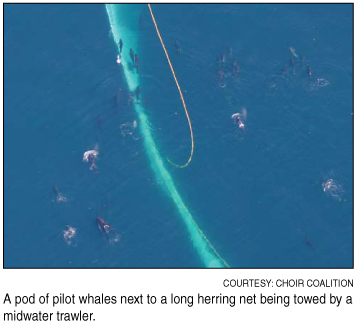 Bycatch is another concern. By the time trawlers haul in the
nets, everything in them is typically dead. Bycatch stand little
chance of being thrown back alive. “There are questions about
what the fleet may be catching in terms of bycatch,” Steele
noted. “The concern voiced to the council is about the need
for better monitoring and accounting of catch and bycatch.” Bycatch is another concern. By the time trawlers haul in the
nets, everything in them is typically dead. Bycatch stand little
chance of being thrown back alive. “There are questions about
what the fleet may be catching in terms of bycatch,” Steele
noted. “The concern voiced to the council is about the need
for better monitoring and accounting of catch and bycatch.”
Herring fishermen argue that they’re abiding by management
rules, and that no evidence of a bycatch problem exists. Herring
swim high in the water column, they point out, and the trawl nets
don’t come anywhere near the seafloor, where groundfish such
as cod and haddock spend most of their time.
Furthermore, they said, the NEFMC just implemented new regulations
in the summer of 2007. Under the new amendments, only fixed-gear
and purse-seine fishermen can harvest herring in the inshore area
between June and September. Mary Beth Tooley, a spokesperson for
the Small Pelagics Group, which represents fishing vessel owners,
said it’s too soon to know if the new amendment will have
a positive effect—and it’s unfair to saddle fishermen
with additional regulations in the meantime. “They have no
new information from the last go-around,” she said.
The Herring Alliance is calling for the NEFMC to create a monitoring
system that ups the number of observers on herring boats. But
that’s easier said than done. In 2005, observers were present
on about 20 percent of herring fishing trips, Steele said. The
last two years, that number has been much lower. Observers are
funded by the National Marine Fisheries Service, she said, and
NMFS has to prioritize the budget it’s handed by Congress.
For the record, stressed Tooley, “we’re not against
increasing observer coverage.” Rather, she said, the industry
resists the idea put forward by some environmentalists that boat
owners should pay upwards of $1,000 a day to fund observers themselves.
“We don’t think it’s fair to single us out among
all the fisheries and say you have to have your own observers,”
she said.
Now that the NEFMC has voted to add herring to its 2008 priority
list, there’s nothing for either side to do except wait.
It could be two years or more before any amendments are finalized
and added to the management plan, Steele said. The council will
take a hard look at the fishery, she said, and explore different
programs for monitoring just what goes into the nets. “We
need more information to better identify what specific problems
there may be,” Steele said, adding that questions about bycatch
and inshore depletion, “certainly are valid concerns. And
I think the council has responded to that.”
Kirsten Weir is a free-lance writer in Saco, Maine, who
focuses on science, health and the environment.
Fast Facts: Lobster Snacks
Once upon a time, most of the herring netted in the Gulf of
Maine ended up in sardine tins. Today, only one cannery remains
in New England. Some 60 to 80 percent of herring landings return
to the sea as lobster bait.
The fish are so popular as bait, in fact, that Gulf of Maine
Research Institute scientists are now investigating whether all
that herring bait has fueled the growth of the lobster population
in the Gulf of Maine. |
|






